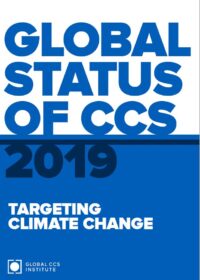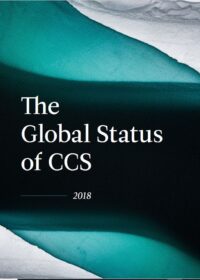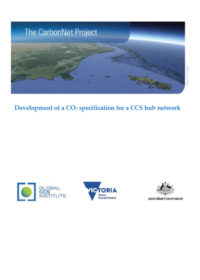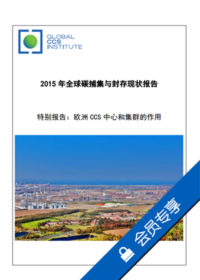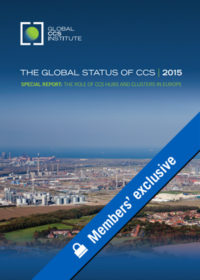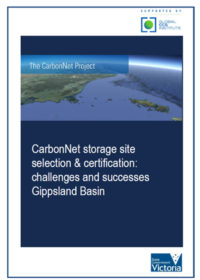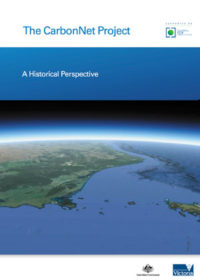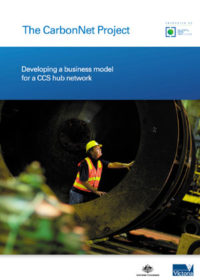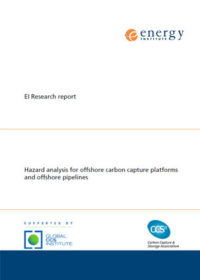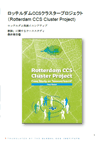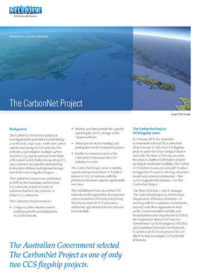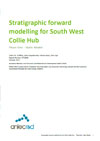Resources
Publications
Our publications, reports and research library hosts over 500 specialist reports and research papers on all topics associated with CCS.
View our Publication Library Disclaimer.
Filter by
Global Status of CCS Report: 2019
9th December 2019
Topic(s): Carbon capture and storage (CCS), CO2 hubs, CO2 storage, CO2 transport, Policy law and regulation
The 2019 Global Status of CCS report documents important milestones for CCS over the past 12 months, its status across the world and the key opportunities and benefits the technology presents.
The report provides detailed information on, and analyses of, the global CCS facility pipeline, policy, CO2 storage and the legal and regulatory environment. In addition, four regional updates and a CCS Technology section further demonstrate global development and the versatility of CCS across a variety of applications and industry sectors.
Disclaimer
The content within the Global CCS Institute Publications, Reports and Research Library is provided for information purposes only. We make every effort and take reasonable care to keep the content of this section up-to-date and error-free. However, we make no claim as to its accuracy, currency or reliability.
Content and material featured within this section of our website includes reports and research published by third parties. The content and material may include opinions and recommendations of third parties that do not reflect those held by the Global CCS Institute.
Global Status of CCS Report: 2018
10th December 2018
Organisation(s): Global CCS Institute
Topic(s): Carbon capture and storage (CCS), CCS policy, CO2 hubs, CO2 storage, CO2 transport
The Global Status of CCS Report 2018 documents the status of CCS around the world and significant operational milestones over the past 12 months. It demystifies common misunderstandings about the technology and identifies where and how it can, and must, be more widely deployed. It also tracks the worldwide progress of CCS technologies and the key opportunities and challenges CCS faces.
Disclaimer
The content within the Global CCS Institute Publications, Reports and Research Library is provided for information purposes only. We make every effort and take reasonable care to keep the content of this section up-to-date and error-free. However, we make no claim as to its accuracy, currency or reliability.
Content and material featured within this section of our website includes reports and research published by third parties. The content and material may include opinions and recommendations of third parties that do not reflect those held by the Global CCS Institute.
The CarbonNet Project: development of a CO2 specification for a CCS hub network
25th May 2016
Topic(s): Carbon capture use and storage (CCUS), CO2 hubs, CO2 transport
The Global CCS Institute is supporting the development of the CarbonNet Project through a series of reports and enable the sharing of knowledge throughout its development. The CarbonNet Project, located in the Victoria, Australia is in its feasibility phase. It is planning the development of a hub-based network that will centre on a large capacity pipeline (up to 5 million tonnes per annum) to deep, secure storage sites in the offshore Gippsland Basin.
A critical aspect of hub-based network projects in general is the complex process of gathering multiple sources of CO2 (e.g. coal-fired power stations, natural gas processing, etc.), each with unique properties, into a single pipeline and into a storage site. This report explores the details of different specifications from the various potential capture methods and feedstock, which could come together and how that could impact the specifications of infrastructure and the storage site itself.
The report outlines the lower and upper bounds of the potential CO2 specifications a hub project could encounter and proposes technically achievable limitations on the whole of project chain. This includes source proponents’ requirement, pipeline integrity and composition, requirements of the storage site, as well as health, safety and environment factors. Finally, the report outlines the techno-economic trade-off between additional processing for the CO2 sources and the impact on transport and storage.
By undertaking these studies in the early phase of project development, barriers such as restrictive specifications can be minimised and this could reduce costs overall, whilst increasing the viability of the multi-user system- the key platform for any hub-based network project.
This report is a product of work undertaken by Parsons Brinckerhoff with inputs from the CarbonNet Project team.
Disclaimer
The content within the Global CCS Institute Publications, Reports and Research Library is provided for information purposes only. We make every effort and take reasonable care to keep the content of this section up-to-date and error-free. However, we make no claim as to its accuracy, currency or reliability.
Content and material featured within this section of our website includes reports and research published by third parties. The content and material may include opinions and recommendations of third parties that do not reflect those held by the Global CCS Institute.
2015 年全球碳捕集与封存现状报告。特别报告:欧洲CCS 中心和集群的作用
18th February 2016
Topic(s): Carbon capture use and storage (CCUS), CO2 hubs
此问答型特别报告关注于CCS中心和集群对加强CCS在欧洲的部署所能起到的作用,尤其是在从工业生产中降低排放的情形下。
Disclaimer
The content within the Global CCS Institute Publications, Reports and Research Library is provided for information purposes only. We make every effort and take reasonable care to keep the content of this section up-to-date and error-free. However, we make no claim as to its accuracy, currency or reliability.
Content and material featured within this section of our website includes reports and research published by third parties. The content and material may include opinions and recommendations of third parties that do not reflect those held by the Global CCS Institute.
The global status of CCS: 2015. Special report: the role of CCS hubs and clusters in Europe
4th November 2015
Topic(s): Carbon capture use and storage (CCUS), CO2 hubs, CO2 utilisation, Economics
This question and answer style special report focuses on the role CCS hubs and clusters can play in enhancing the deployment of CCS in Europe, especially in the context of reducing emissions from industrial processes.
Disclaimer
The content within the Global CCS Institute Publications, Reports and Research Library is provided for information purposes only. We make every effort and take reasonable care to keep the content of this section up-to-date and error-free. However, we make no claim as to its accuracy, currency or reliability.
Content and material featured within this section of our website includes reports and research published by third parties. The content and material may include opinions and recommendations of third parties that do not reflect those held by the Global CCS Institute.
The CarbonNet Project. CarbonNet storage site selection & certification: challenges and successes
14th September 2015
Topic(s): Carbon capture use and storage (CCUS), CO2 hubs, CO2 storage
The Global CCS Institute presents the second report by CarbonNet to identify and then characterise suitable storage sites in the offshore Gippsland Basin. The CarbonNet Project is investigating the potential to establish a CCS Hub bringing together multiple CO2 capture projects in Victoria’s Latrobe Valley, transporting CO2 via a shared pipeline and injecting it into the offshore Gippsland Basin.
This report details the history of the site selection process between 2010 and 2015. The search for a storage site has followed international best practice, aligned to DNV GL Recommended Practice (DNV-RP-J203) to provide decision makers and stakeholders with independent expert assurance of environmentally safe, long-term geological storage.
This report is authored by George Carman, Nick Hoffman, and the CarbonNet Project. Chris Consoli, Institute Senior Adviser for Storage, Asia-Pacific also provides an overview of the report in an Insight available on the Global CCS Institute website.
Disclaimer
The content within the Global CCS Institute Publications, Reports and Research Library is provided for information purposes only. We make every effort and take reasonable care to keep the content of this section up-to-date and error-free. However, we make no claim as to its accuracy, currency or reliability.
Content and material featured within this section of our website includes reports and research published by third parties. The content and material may include opinions and recommendations of third parties that do not reflect those held by the Global CCS Institute.
The CarbonNet Project: a historical perspective
25th June 2015
Topic(s): Carbon capture use and storage (CCUS), CO2 hubs
Victoria’s Department of Economic Development, Jobs, Transport and Resources prepared this Knowledge Sharing Report for the Global Carbon Capture and Storage Institute. This report provides a historical perspective of CarbonNet from prior to its inception to now. It is intended to help project participants and their stakeholders understand how the vision of a network hub concept has developed in Victoria, Australia.
Disclaimer
The content within the Global CCS Institute Publications, Reports and Research Library is provided for information purposes only. We make every effort and take reasonable care to keep the content of this section up-to-date and error-free. However, we make no claim as to its accuracy, currency or reliability.
Content and material featured within this section of our website includes reports and research published by third parties. The content and material may include opinions and recommendations of third parties that do not reflect those held by the Global CCS Institute.
The CarbonNet Project: developing a business model for a CCS hub network
25th June 2015
Topic(s): Carbon capture use and storage (CCUS), CO2 hubs
Victoria’s Department of Economic Development, Jobs, Transport and Resources prepared this Knowledge Sharing Report for the Global Carbon Capture and Storage Institute. This report defines a generic Carbon Capture and Storage (CCS) hub project, and outlines the commercial framework developed to support analysis of roles and responsibilities between the public and private sector in developing a CCS hub project.
Disclaimer
The content within the Global CCS Institute Publications, Reports and Research Library is provided for information purposes only. We make every effort and take reasonable care to keep the content of this section up-to-date and error-free. However, we make no claim as to its accuracy, currency or reliability.
Content and material featured within this section of our website includes reports and research published by third parties. The content and material may include opinions and recommendations of third parties that do not reflect those held by the Global CCS Institute.
Research report: hazard analysis for offshore carbon capture platforms and offshore pipelines
1st September 2013
Topic(s): Carbon capture use and storage (CCUS), CO2 hubs, CO2 transport, Health safety and environment
The intention of this publication is to provide a basic guide for the health and safety hazard analysis for offshore management of CO2 pipelines and platforms, where CO2 will be present as a part of carbon capture and storage (CCS) installations; communicate existing knowledge on pipeline and offshore facility design and operation; and identify areas of uncertainty where existing knowledge cannot be applied with sufficient confidence, considering the scale and nature of expected CCS operations in the future.
Disclaimer
The content within the Global CCS Institute Publications, Reports and Research Library is provided for information purposes only. We make every effort and take reasonable care to keep the content of this section up-to-date and error-free. However, we make no claim as to its accuracy, currency or reliability.
Content and material featured within this section of our website includes reports and research published by third parties. The content and material may include opinions and recommendations of third parties that do not reflect those held by the Global CCS Institute.
ロッテルダムCCSクラスタープロジェクト – 教訓」に関するケーススタディ
5th June 2013
Topic(s): Carbon capture use and storage (CCUS), CO2 hubs
ロッテルダム気候イニシアティブ(RCI: Rotterdam Climate Initiative)は、ロッテルダム地域においてCO2回収貯留(CCS)を実現するため、懸命に取組を続けている。ロッテルダムにおけるCCS活動は2006年に始まり、現在までに18を超える大手企業が協力し、CO2回収プロジェクト及びCCSインフラネットワークに関する、実行可能性レベルでの工学調査を実施してきた。
本書はこのケーススタディの最終報告書である。以下の四つのテーマを取り扱っている。
- 理解可能なストーリー展開-第2章では、ロッテルダムCCS手法に関する出来事の全てを簡潔に要約した。
- (新規及びオリジナルの)拡張分析-第3章では、4者の外部利害関係者による多面的な解析により、読者はロッテルダム手法の長所及び短所をより鮮明に把握できるはずである。我々が選んだ利害関係者の意見は、政治家、政策立案者、起業家、(CCS)ネットワーク事務局のものである。それぞれの意見から、読者はロッテルダムで何が起きたかについての見解及び印象を得ることができる。
- 新たなCCSプロジェクトの創始者のためのマニュアル-第4章では、ロッテルダムで学んだ教訓から、プロジェクトを開始するリーダーのためのガイドラインを作成した。ガイドラインは、信頼関係の構築、クラスタープロジェクトの組織化、貯留の利用可能化、コミュニケーション及び支援運動の問題などを扱っている。
- ケーススタディの「インとアウト」に関する考察-第5章では、1年以上に及んだ興味深い作業(労働時間は3,000時間弱)を検討する。この検討では、本ケーススタディの結果やワークショップ及び知識共有への適用において、用いた理論とその応用を扱っている。本章は今後の作業のための提案で締めくくっている。
Disclaimer
The content within the Global CCS Institute Publications, Reports and Research Library is provided for information purposes only. We make every effort and take reasonable care to keep the content of this section up-to-date and error-free. However, we make no claim as to its accuracy, currency or reliability.
Content and material featured within this section of our website includes reports and research published by third parties. The content and material may include opinions and recommendations of third parties that do not reflect those held by the Global CCS Institute.
Disclaimer
The content within the Global CCS Institute Publications, Reports and Research Library is provided for information purposes only. We make every effort and take reasonable care to keep the content of this section up-to-date and error-free. However, we make no claim as to its accuracy, currency or reliability.
Content and material featured within this section of our website includes reports and research published by third parties. The content and material may include opinions and recommendations of third parties that do not reflect those held by the Global CCS Institute.
Stratigraphic forward modelling for South West Collie Hub. Phase one: static model
1st October 2012
Topic(s): Carbon capture use and storage (CCUS), CO2 hubs
A stratigraphic forward model of the time period from 250 Ma to 182 Ma (Olenekian to Pliensbachian Base Wonnerup equivalent to top Eneabba equivalent) has been created in that part of the South Perth basin that is a candidate area for geological sequestration of carbon dioxide. We used the CSIRO Sedsim stratigraphic forward modelling software constrained by available well and seismic data and previous published geological studies. The goal was to determine the distribution of grainsize and primary porosity (and permeability via the same transfer function used by Schlumberger) of Triassic and Lower Jurassic sediments below seismic resolution and away from well data across the study area around the Harvey‐1 well.
Disclaimer
The content within the Global CCS Institute Publications, Reports and Research Library is provided for information purposes only. We make every effort and take reasonable care to keep the content of this section up-to-date and error-free. However, we make no claim as to its accuracy, currency or reliability.
Content and material featured within this section of our website includes reports and research published by third parties. The content and material may include opinions and recommendations of third parties that do not reflect those held by the Global CCS Institute.
